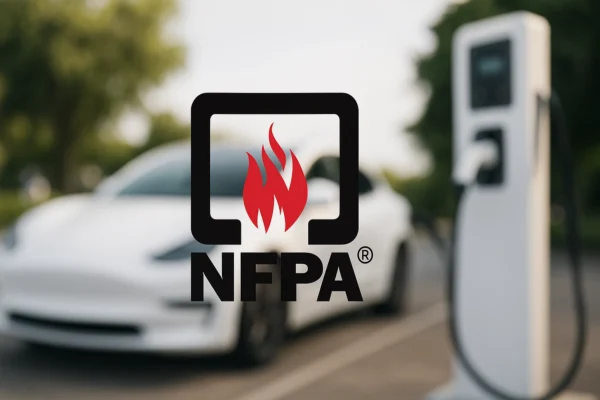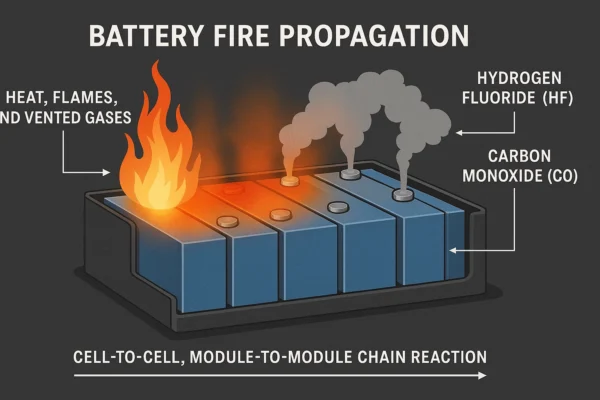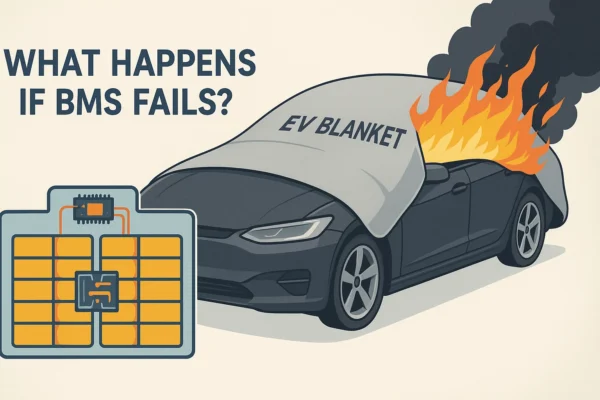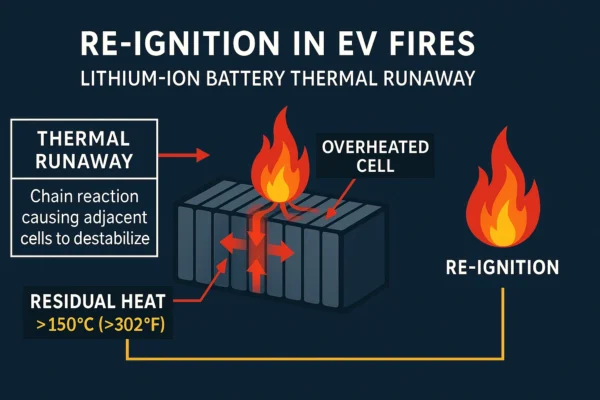One of the biggest challenges in electric vehicle (EV) fires is re-ignition—when a fire that seems extinguished suddenly flares up again, sometimes hours or even days later. According to the National Transportation Safety Board, up to 40% of EV fires involve some form of delayed re-ignition.
This risk stems from thermal runaway in lithium-ion batteries, a chain reaction that generates extreme heat and gas. Even after flames are out, residual heat can reignite adjacent cells—especially when battery packs are tightly sealed and hard to cool.
Standard suppression methods, such as surface water application, are often ineffective. Research from UL Fire Safety Research Institute shows that internal hotspots can persist, requiring extended monitoring and specialized tactics, including thermal imaging and prolonged water application.
As a result, EV fires demand more time, resources, and training to manage safely—posing new risks for fire departments and first responders.
Re-Ignition in EV Fires
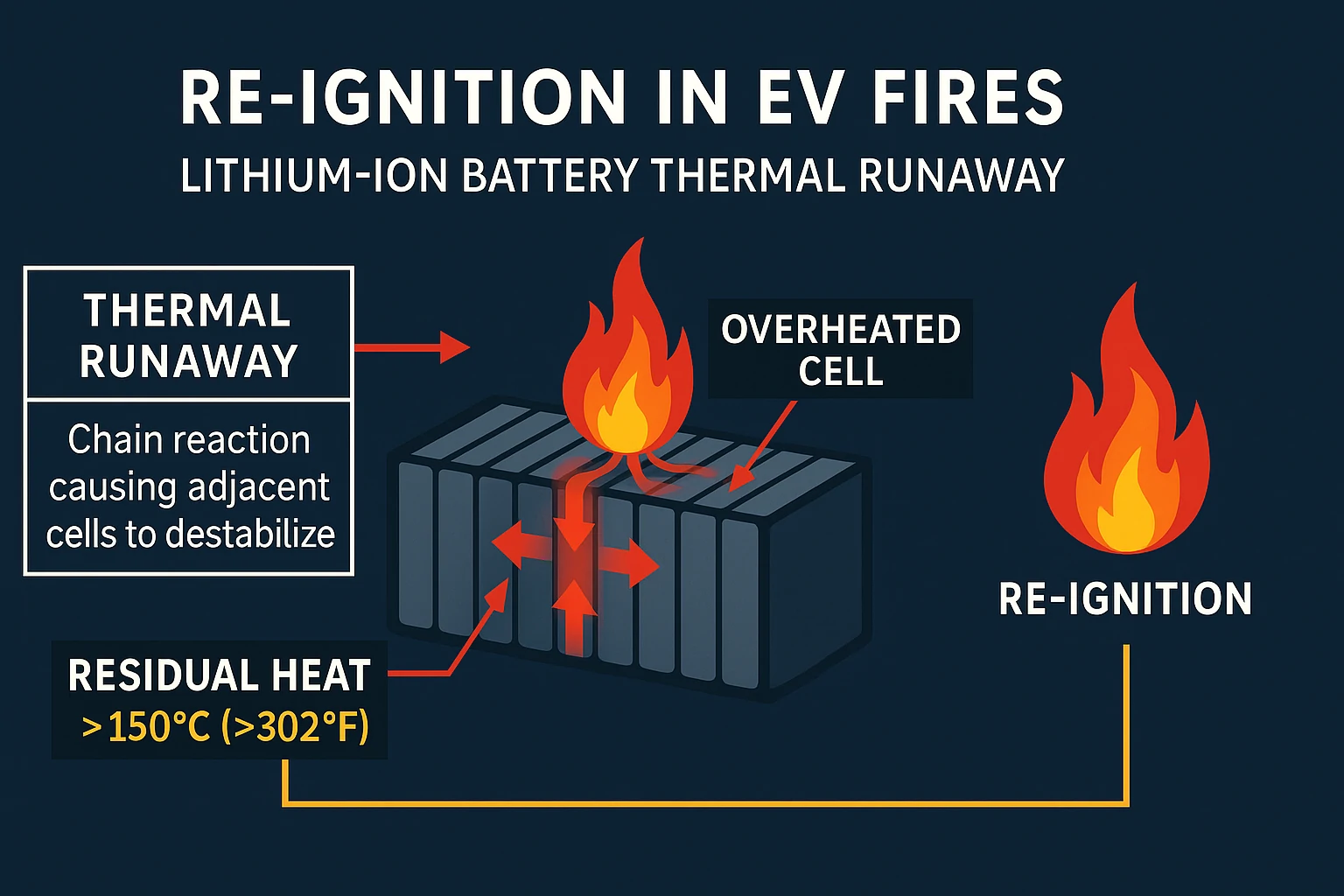
Re-ignition in electric vehicle (EV) fires refers to the unexpected recurrence of flames or thermal events after the initial fire has been extinguished—sometimes hours or even days later. This phenomenon is primarily caused by thermal runaway, a chain reaction where one cell in a lithium-ion battery overheats and triggers adjacent cells to destabilize and release energy uncontrollably. Unlike traditional fires, this process can persist without the presence of external oxygen, making suppression significantly more complex.
Once a fire appears to be out, residual heat trapped deep within the battery modules—often exceeding 150°C (302°F)—can silently propagate, reigniting nearby materials. This is especially dangerous because surface indicators (like smoke or flames) may be absent until the thermal spike occurs again. Research by the National Transportation Safety Board (NTSB) and studies from UL Fire Safety Research Institute (FSRI) indicate that lithium-ion battery packs can remain thermally unstable for up to 24 hours, and in some cases, re-ignite as late as 72 hours post-extinguishment.
The consequences are significant. A 2023 report from the International Association of Fire Chiefs (IAFC) noted that up to 22% of EV fires respond with multiple flare-ups, requiring 10–20 times more water than an internal combustion engine vehicle fire. Fire departments are often forced to monitor EV wreckage for extended periods or transport the vehicle in containment pods, adding cost, logistical strain, and personnel risk.
Because thermal runaway is electrochemical rather than purely combustion-based, standard firefighting tactics may fail to fully cool internal cells, making re-ignition a latent and unpredictable hazard for first responders and tow crews alike.
Containing Re-Ignition: From Submersion Tanks to Smarter Solutions

Because the root cause of re-ignition in electric vehicle (EV) fires is thermal runaway—a self-sustaining chemical reaction inside the lithium-ion battery—traditional extinguishment efforts are often temporary. Submersion tanks have become a common containment method in many U.S. fire departments. These tanks are designed to cool damaged battery packs by fully immersing them in water for extended periods, effectively slowing the chain reaction and suppressing volatile off-gassing.
However, submersion-based methods introduce two significant operational drawbacks. First, their deployment is time-consuming and labor-intensive. Unlike conventional vehicle fires—where suppression can begin almost immediately via hose lines—EV battery fires require lengthy scene control and on-site monitoring. Firefighters may need to remain on-scene for hours or even days to monitor the battery pack’s thermal state and prevent reignition, which increases safety risks and resource demands.
Second, the logistical burden of transporting and storing submersion tanks is nontrivial. These tanks occupy substantial space on fire apparatus, making them impractical for large-scale incidents or departments with limited vehicle capacity. In multi-incident scenarios, the limited number of tanks may delay containment or require mutual aid coordination.
In recent years, EV fire blankets have emerged as a field-tested, space-efficient alternative for re-ignition mitigation. Designed to withstand temperatures exceeding 1000°C (1832°F), these multi-layer thermal barriers encapsulate the vehicle, depriving the fire of oxygen while containing toxic vapors and radiant heat. Unlike submersion tanks, they are lightweight, reusable, and deployable by two firefighters in under 90 seconds. Their design allows for immediate isolation of the thermal event—whether it’s the initial ignition or subsequent reignition—without the need for prolonged water cooling or equipment-heavy logistics.
EV fire blankets have already been adopted by over 300 U.S. and European fire departments and have demonstrated a reduction in re-ignition incidents by up to 87% in operational trials. Many models comply with performance standards including ISO 1182 (non-combustibility) and EN 13501-1 for reaction to fire, and are compatible with NFPA 1901 vehicle integration guidelines.
As EV adoption accelerates, especially in urban and highway traffic environments, the need for agile, repeatable, and scalable fire containment tools is rising. EV fire blankets offer a modern, field-proven solution to the complex problem of thermal runaway and battery reignition—without the operational downsides of submersion tanks.
With thermal runaway capable of triggering fires hours or even days after initial suppression, fire departments must rethink both their tactics and tools. Submersion tanks, while effective in theory, pose logistical and operational challenges that can compromise safety and efficiency.
That’s where EV fire blankets offer a next-generation solution: rapid deployment, minimized re-ignition risks, and enhanced containment—all without the need for large volumes of water or prolonged monitoring. As EV adoption accelerates, adopting purpose-built solutions is no longer optional—it’s critical.
At Safeprotex, we specialize in emergency containment solutions designed to meet the evolving challenges of the electric vehicle era. Our NFPA-compliant EV fire blankets provide dependable, field-tested containment for EV fires and re-ignition scenarios.
Contact our experts today to learn how our solutions can enhance your department’s EV fire readiness and operational safety.

